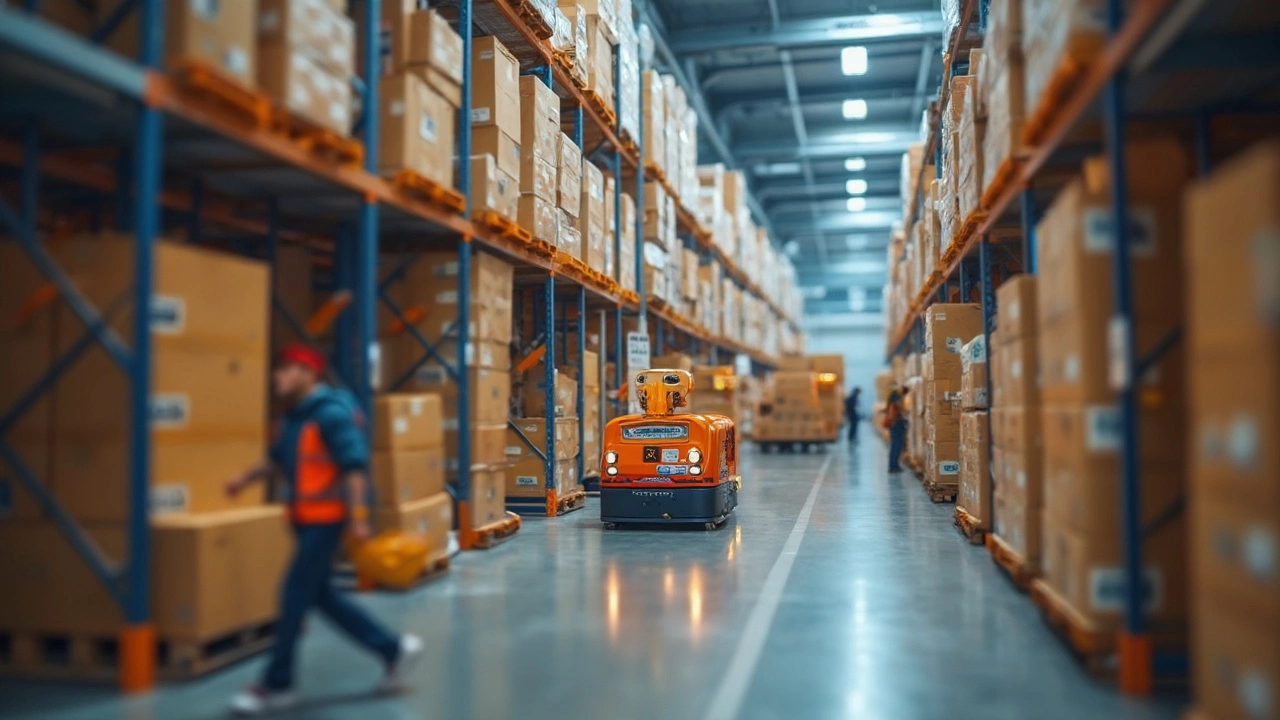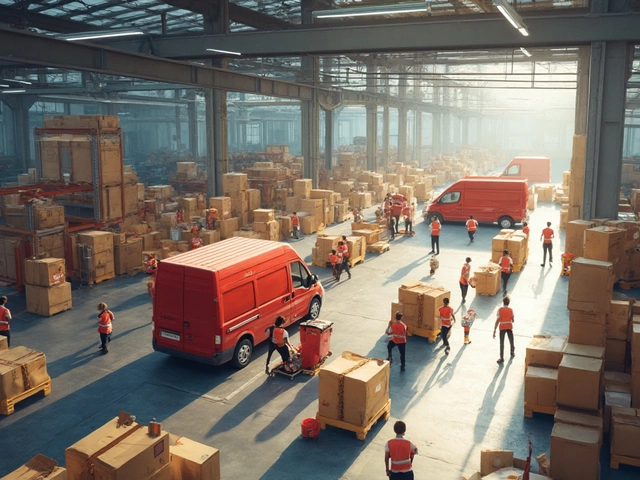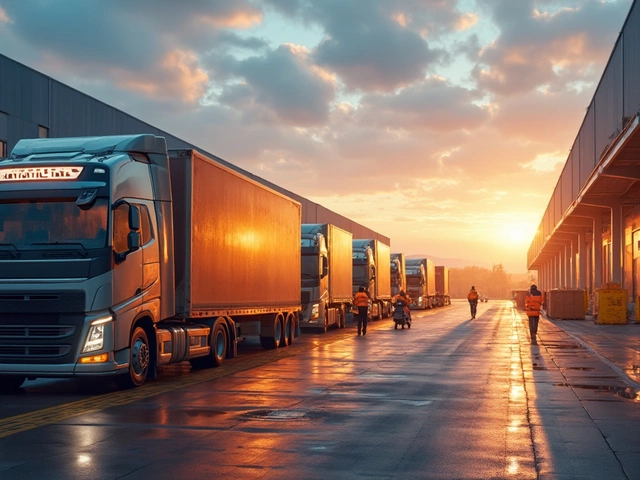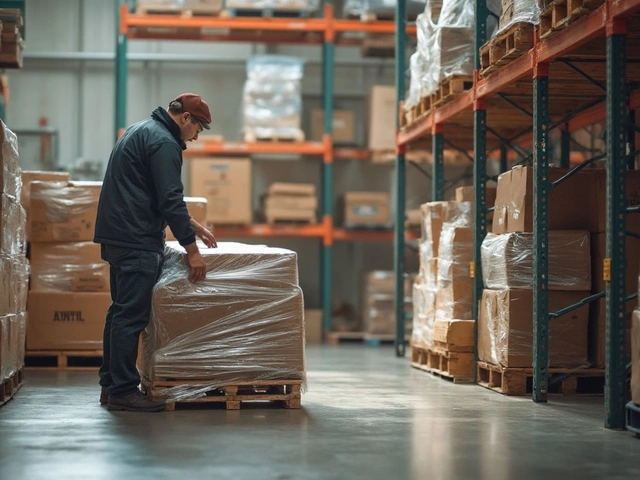Ever wondered what really happens when you order socks at midnight and they show up two days later? That’s e-commerce working its magic. It isn’t just about buying things online—e-commerce is this entire system that moves stuff from someone’s cart to their hands, using websites, warehouses, couriers, and a bunch of clever software in the background.
The crazy part is how variety in e-commerce is mind-blowing. From food delivery apps getting your burger hot, to your neighbor selling homemade soap on Etsy—if you've bought, sold, or shipped something using the internet, you've been part of e-commerce. It’s not just for giant companies (hello, Amazon) but also for tiny businesses and even side hustles run from someone’s kitchen table.
People often forget about the logistics—the behind-the-scenes action that actually gets your order from A to B. Without it, online shopping would be all talk and no delivery. In the next sections, you'll see real examples, find out what makes the logistics tick, and pick up tips to make your next e-commerce experience smoother, whether you’re clicking 'add to cart' or shipping out orders yourself.
- E-commerce: What Does It Actually Mean?
- Types of E-commerce: Shopping, Services, and Surprises
- Popular E-commerce Examples You See Every Day
- Logistics: The Backbone of E-commerce
- How E-commerce Logistics Works Step by Step
- Tips for Better Online Shopping and Selling
E-commerce: What Does It Actually Mean?
E-commerce is basically buying or selling stuff using the internet. It covers way more than just your favorite online store. Any time money changes hands over a website, app, or social media—it's e-commerce. This includes digital downloads, subscriptions, and even paying your bills online. The word "e-commerce" first popped up in the late '90s, but now it’s everywhere, and it’s getting bigger every year.
People sometimes confuse e-commerce with just regular online shopping, but there's more to it. There’s business-to-consumer (like when you shop on Amazon), business-to-business (companies buying from each other), and even consumer-to-consumer (think eBay or Facebook Marketplace). So, if you’ve ever bought a secondhand chair from a stranger online, congratulations—you’ve done e-commerce.
To get a sense of how big this stuff is, take a look at these numbers from Statista for 2024:
| E-commerce Category | Global Sales (USD) |
|---|---|
| Retail | $6.3 Trillion |
| Food Delivery | $340 Billion |
| Travel & Events | $870 Billion |
Not all e-commerce platforms are huge. Small shops or even one-person businesses are thriving, too. They use tools like Shopify, Etsy, or even Instagram to sell. E-commerce takes away lots of borders—someone in your country might send you homemade cookies, or you could order headphones from another continent.
Here’s what makes e-commerce different from traditional shopping:
- You can buy or sell anytime—no opening hours.
- Your market isn’t just the town you live in. It’s global.
- Payment, tracking, reviews, and even customer support are often automated.
So, whenever you click a few buttons online and spend (or earn) money, you’re part of a massive, super-connected world called e-commerce. And it keeps growing and changing, fast.
Types of E-commerce: Shopping, Services, and Surprises
E-commerce isn’t just about buying sneakers or kitchen gadgets online. There are actually different flavors of e-commerce that go way beyond the stuff you can put in a virtual cart. If you look at the whole scene, e-commerce fits into a few main types, each with its own perks and surprises.
E-commerce shopping, also called "retail e-commerce," is what most folks think of—ordering products straight from a website or app. Sites like Amazon, Walmart, and Alibaba dominate this game. And here's a wild fact: In 2024, global retail e-commerce sales hit about $6.3 trillion. That’s a number with way too many zeros to imagine, but it shows how popular online shopping has become.
- Product Shopping: This covers anything you can ship in a box—clothes, electronics, books, even groceries. Big brands like Target and indie shops on Shopify are all in this category.
- Services: E-commerce isn’t just things you mail. It’s also stuff you don’t even touch, like streaming Netflix shows, buying travel insurance, or scheduling a Zoom call with a tutor. If you’ve booked an Uber, paid for online therapy, or signed up for a digital yoga class, that’s e-commerce in action too.
- C2C (Consumer-to-Consumer): Think eBay, Facebook Marketplace, or even peer-to-peer payments via PayPal and Venmo. Regular people can buy and sell with no big business in the middle.
- B2B (Business-to-Business): Companies buying from each other. Not the most glamorous, but super important — like a restaurant chain ordering supplies from a wholesaler’s portal.
- Surprises and Subscriptions: Subscription boxes exploded in popularity. From socks, snack boxes, to monthly coffee deliveries—Dollar Shave Club and Blue Apron nailed this model. Plus, there’s disaster response e-commerce: after something big like a hurricane, folks rush to order essentials online, pushing logistics to the limit.
There are a few hybrids, too. For example, Nike now lets you personalize sneakers online (merging digital and physical shopping), and Etsy sellers do both physical and digital goods like printables or fonts.
| Type | Examples | What Makes It Different? |
|---|---|---|
| Product Shopping | Amazon, Walmart, Etsy | Tangible goods shipped to you |
| Services | Netflix, Uber, Coursera | Intangible, delivered digitally or in person |
| C2C | eBay, Facebook Marketplace | People buy/sell with each other |
| B2B | Alibaba, restaurant suppliers | Businesses trading with businesses |
| Subscriptions | Blue Apron, Dollar Shave Club | Regular, recurring orders |
Each type has its own rules for payment, shipping, and even returns, so the way logistics work can be totally different. If you’re thinking about shopping or starting a side business, understanding these types helps you pick the right tools and avoid surprises down the road.
Popular E-commerce Examples You See Every Day
If you want to see how e-commerce plays out in your daily life, think about where you buy clothes, gadgets, or even pizza these days. It's either a big online marketplace, a brand’s website, or an app on your phone.
Let’s get concrete. Amazon is the giant in e-commerce. It started as a bookstore in the 1990s and now ships almost anything you can think of—electronics, groceries, even furniture—to more than 100 countries. Amazon Prime members get same-day or next-day delivery in many cities, all thanks to a wild system of warehouses and delivery drivers.
Then there’s eBay, the king of auctions, where you can bid for everything from old sneakers to vintage toys. Sellers list the stuff, buyers compete for it, and shipping is often handled through the platform’s system.
Don’t forget about Walmart.com. Walmart took its superstore game online, letting shoppers order groceries or home goods for pickup or delivery. In the U.S., same-day curbside pickup exploded in popularity during the pandemic. Target, Best Buy, and Home Depot do the same thing, mixing online and in-store experiences.
For clothing and lifestyle, sites like ASOS, Zara, and Nike let you try out trends without leaving your couch. You order, they ship, and, if the fit’s off, you send it back—returns are now part of the routine thanks to clear policies.
Got a craving? Delivery apps like Uber Eats, DoorDash, and Grubhub count as e-commerce too. You order dinner through an app, it shows up at your door, and payment’s handled online or digitally.
There’s also Shopify-powered stores, which let small businesses and startups skip the technical headaches and set up shop quickly. Maybe your friend makes crafts or sells T-shirts from home—odds are, Shopify or Etsy is helping them get those products to you.
This mix of global giants and garage businesses is what makes e-commerce adaptable to almost anything you want, need, or just crave at 2 a.m. If you’ve swiped, clicked, tapped, or shouted at your smart speaker to buy something, you’ve experienced it firsthand.

Logistics: The Backbone of E-commerce
Take away logistics, and e-commerce totally falls apart. It’s not magic—it’s warehouses, trucks, planes, software, and real people hustling to get your package where it needs to go. Think about how Amazon gets millions of orders to doorsteps in just a day or two. That’s a crazy amount of coordination between inventory, packing, shipping, and delivery partners. None of it works without tight logistics.
Here’s how it usually goes: after you click “buy,” the system checks if your item’s in stock, then someone (or sometimes a robot) grabs it from a warehouse shelf. It gets packed, labeled, and passed off to a carrier like UPS, FedEx, or your local post office. Tracking numbers get sent, so you watch your stuff travel from city to city. Sometimes, when you order from a marketplace like eBay or Etsy, the seller ships it from their own home instead of a big warehouse.
Speed is a big deal. In 2023, 77% of shoppers said they’d ditch their carts if shipping options were slow. No wonder companies push for same-day and next-day delivery, even if it means building more warehouses closer to neighborhoods. Major online stores even let you pick up from lockers or convenience stores when home delivery isn’t convenient.
What makes e-commerce logistics tough? It’s scale. During big sales—think Black Friday—some warehouses process over a million packages a day. Keeping items in stock, updating tracking info, handling returns, and dealing with “lost” packages all add layers of work no shopper really sees.
- Real-time inventory tracking helps sellers avoid “out of stock” headaches.
- Automated sorting in large warehouses speeds up processing.
- Smart routing gets packages to your door faster and cuts down on shipping costs.
- Returns—also known as reverse logistics—are getting faster, with prepaid labels and drop-off options now common.
It’s a global thing, too. Take cross-border sales: 58% of e-commerce users have ordered from another country. This brings extra challenges—customs checks, import fees, and longer delivery times.
| Logistics Fact | What It Means for Shoppers |
|---|---|
| Average Amazon Prime delivery speed (2024): | 1.8 days in US cities |
| Largest fulfillment center size: | Over 1 million square feet (about 23 football fields!) |
| Global e-commerce parcel volume in 2023: | 161 billion packages delivered |
If you're a seller, nailing your logistics can be the difference between raving reviews or angry rants. If you're shopping, knowing what goes on behind the scenes can help you spot brands that actually deliver on time, not just make big promises.
How E-commerce Logistics Works Step by Step
When you click ‘buy now,’ there’s a bunch of steps that kick in just to get your order to your door. No matter the size of the business, these steps are pretty much the same everywhere. Let’s break down what really happens in the world of e-commerce logistics.
- Order placed: Once you pay, your order pings the system. A confirmation goes out instantly, both to you and to the seller.
- Processing and picking: The warehouse team gets notified. Either a human picker or a robot zooms around to grab your items—think of those videos of Amazon robots moving shelves.
- Packing: The team packs your goods, often double-checking things to avoid the dreaded ‘wrong item’ delivery. Some warehouses use smart scanners and even AI to spot mistakes before the box gets taped shut.
- Labeling and shipping: Once packed, your parcel gets a shipping label slapped on it. The system picks the fastest or cheapest carrier (like UPS, DHL, or the post office).
- First-mile transport: Your package leaves the warehouse, often getting bulked together with others heading in the same direction.
- Sorting and last-mile delivery: At the carrier’s local hub, packages are sorted by address. A delivery driver loads up a van for your neighborhood and—fingers crossed—makes it to your door on time.
- Delivery confirmation: Most systems update you with a tracking email or app notification. Some even snap a photo of the package at your door as proof.
A lot of folks don’t realize how well-oiled this machine has become. For example, in 2024, Amazon shipped about 7.7 billion packages worldwide, mostly using their own delivery network. Smaller sellers can tap into similar networks through services like Fulfillment by Amazon or Shopify’s Fulfillment Network.
| Step | Tech Used | Who Handles It? |
|---|---|---|
| Order Processing | Order Management Software | Seller/Warehouse |
| Picking | Barcodes, Robots | Warehouse Staff/Robots |
| Packing | Scanners, AI | Packer/Quality Check |
| Shipping | Carrier APIs, Tracking | Carrier (UPS, DHL, FedEx, etc.) |
| Delivery | GPS, Route Optimization | Driver/Courier |
If you’re running an online shop, track every step closely. Delays usually happen at the packing or last-mile stage, especially during busy seasons like November (hello, Black Friday). Integrating your shop with shipping partners and using real-time tracking cuts down on delivery headaches for both you and your customers.
Tips for Better Online Shopping and Selling
If you want smoother experiences with e-commerce, whether you’re a buyer or a seller, a few simple moves can save you money, time, and stress. Let’s cut straight to what actually works.
- Always Check Seller Ratings and Reviews: Real shoppers leave clues. Low reviews and lots of complaints? Back away. A store with 4.6+ stars on big platforms like Amazon or Shopee is usually safer than a random site with no feedback.
- Compare Prices, But Factor in Shipping: A $5 phone case can easily cost $15 with sneaky shipping. Use comparison sites or browser add-ons to make sure you’re not overpaying, and watch for bundled shipping or free shipping offers.
- Read the Product Details: Make it a habit. Sizing charts, materials, or warranty info are your friends—especially for clothes and electronics. Return rates on clothing from online stores hover around 20-30%, usually because people skip the details.
- Use Secure Payment Methods: Avoid bank transfers to strangers. Stick with protected payments like PayPal, Apple Pay, or credit cards. If something goes wrong, these services are more likely to help you get your money back.
- Track Your Orders: Most platforms, even smaller shops, offer tracking numbers. You’ll spot red flags if your order isn’t moving or if there’s a weird shipping route.
- Fast Response Sells More: If you’re selling, speed is king. Data shows that sellers who answer questions or ship within 24 hours get repeat customers 30% more often.
- Clear Photos Win Sales: Listings with at least three clear, real-life photos get up to 70% more clicks. Use natural light and show items from more than one angle.
- Stay Up to Date on Return Policies: Amazon’s 30-day return window is famous, but smaller stores sometimes only give you a week. Screen-capture return rules before you buy just in case.
Here’s a quick look at the biggest buyer gripes and what causes them, so you can avoid the common headaches:
| Problem | Common Cause | How to Avoid |
|---|---|---|
| Late Delivery | Shipping delays or customs | Choose local sellers or premium shipping for urgent buys |
| Wrong Item | Poor listing details or seller mistake | Double-check product photos and order summary before payment |
| No Refund | Unclear returns policy | Review refund terms, contact support before finalizing |
Last thing: deals that look too good to be true usually are. Stick to trusted platforms, pay attention to the fine print, and ask your questions before checking out. That’s how you avoid e-commerce headaches, whether you’re shopping for fun or running your own online hustle.





